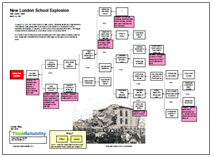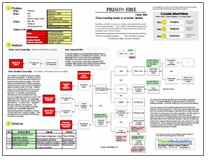By Kim Smiley
On March 18, 1937, the London School of New London, Texas was leveled by a huge explosion. Unfortunately, many people were in the school on the afternoon of the explosion and an estimated 280 students, 15 teachers, 2 visitors and a school secretary were killed. This tragedy remains the worst catastrophe to occur inside a school in American history.
The cause of this tragic incident can be investigated by building a Cause Map, a visual root cause analysis, which shows the cause and effect relationships between the different factors that contributed to the explosion. A Cause Map begins by determining which goals were impacted and in this example the safety goal is the obvious focus. Causes are then added to the Cause Map by asking “why” questions to add additional information. In this example, the safety goal was impacted by the large number of fatalities. The deaths occurred because the school was occupied and the school was destroyed.
 The school was destroyed because there was a large natural gas explosion. The explosion occurred because there was a large quantity of natural gas in the school and a shop teacher turned on a sander and created a spark. The gas was in the school because there was a leak, there was a large quantity of gas was trapped in a void space under the school and the gas leak wasn’t detected. The investigation into this incident was never able to decisively determine what caused the natural gas leak. The void space was under the school because the school was built on a slope. The leak wasn’t detected because the school was using untreated natural gas which is both invisible and odorless.
The school was destroyed because there was a large natural gas explosion. The explosion occurred because there was a large quantity of natural gas in the school and a shop teacher turned on a sander and created a spark. The gas was in the school because there was a leak, there was a large quantity of gas was trapped in a void space under the school and the gas leak wasn’t detected. The investigation into this incident was never able to decisively determine what caused the natural gas leak. The void space was under the school because the school was built on a slope. The leak wasn’t detected because the school was using untreated natural gas which is both invisible and odorless.
Why was the school using untreated natural gas? The school was trying to save money by eliminating their heating bill. The school was located near oil fields and had tapped into a nearby residue gas line to provide heat, saving approximately $300 dollars a month. Using free untreated natural gas was a common practice in the region. The gas company turned a blind eye since natural gas was considered a waste product of oil drilling that was just flared off.
The end result of using free, but untreated natural gas was that no one could detect that the school was filled with natural gas. One spark and the whole school was destroyed along with many, many lives.
As a result of this horrendous accident, all natural gas in the United States is treated to have an odor, usually with mercaptan which smells like rotten eggs, so that leaks can be detected by smell.







